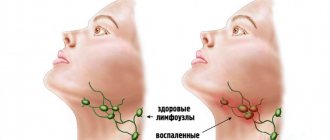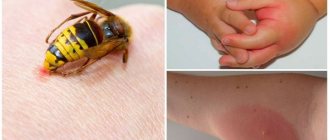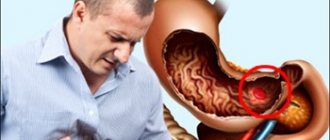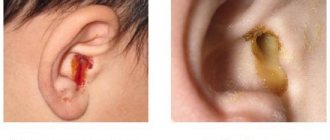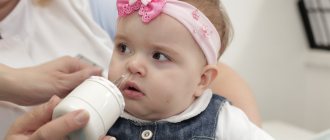What to do if your child has a fever? This question sooner or later arises in every parent who is concerned about the health of their child. But not all mothers and fathers know what temperature can and should be lowered. So, for example, in newborns and babies up to one year old the indicator is up to 37.5-38 degrees, which for us adults is considered elevated, and is the norm. The baby is one month old – does he have a fever? Reduce it only if it rises above 38-38.5.
As for older toddlers, for them this “threshold” is 39-39.5. If the thermometer shows a lower temperature, you should not knock it down. Remember that a child’s fever is an excellent opportunity for the body to fight the infection on its own. Give your baby the opportunity to boost his immunity!
How to reduce a child's temperature?
Now let’s talk about the medications that should definitely be in your first aid kit if a baby is growing up in the family. Thus, pediatricians prohibit the use of drugs such as:
- Aspirin;
- Analgin;
- Nise.
The baby can only be given medications that contain Paracetamol or Ibuprofen. Even if the child has no symptoms, they must be correctly calculated based on the baby’s weight and measured using a special syringe or measuring spoon. You should not use ordinary teaspoons for these purposes, and it is better to completely forget about the concept of “by eye”.
Temperature does not go down - when to call an ambulance
After using paracetamol or ibuprofen, body temperature should decrease at a rate of 0.5–1 0 C per hour. However, sometimes the fever remains at the same level, while the patient’s well-being worsens. In what cases should you call an ambulance or go to the hospital yourself if:
- taking medications according to the regimens described above did not produce any effect;
- for “white” fever, analgin had no effect;
- fever is combined with concomitant pathologies: epilepsy, intracranial hypertension, hydrocephalus, congenital heart defects;
- against the background of fever, the patient refuses to drink and eat, has difficulty breathing and cannot sleep;
- fever is accompanied by severe abdominal pain and incessant vomiting.
If the temperature rises, even despite taking medications, most likely this is a pathological variant of fever - hyperthermic syndrome, in which antipyretic drugs are not effective. This is also one of the reasons to call an ambulance and be hospitalized.
5
1
6
Article rating:
5 out of 5 based on 9 ratings
Author: Atamanenko Alena Valerievna
General practitioner, endocrinologist, physiotherapist. Second category. Work experience more than 9 years.
How to reduce a child's temperature?
Doctors advise using only one drug from the above - with Paracetamol or Ibuprofen in the composition. If the temperature drops poorly or does not drop at all, such medications can be alternated. But you can’t give your baby the combined drug Ibuklin.
Please note that it is not at all necessary to reduce the temperature to normal. It is enough just to knock it down a little for the baby’s well-being to improve at least a little. Don’t forget to feed your little one, because in case of high temperature the loss of fluid increases. Pediatricians say that babies need to drink 100 ml of water per 1 kg of weight.
What to do if your baby gets chickenpox?
Has your child caught chickenpox? Of course, this acute viral disease can also cause high fever. How to proceed in this case?
The most important thing is to choose an antipyretic drug for your baby. Under no circumstances should you use Nurofen. To combat high fever during chickenpox, medications containing Paracetamol are suitable.
What to do if your child has a fever?
Does your baby have a fever? Then you can’t hesitate - you need to urgently consult a doctor. Especially if it is accompanied by:
- rash;
- neck muscle tension;
- abdominal pain;
- vomiting.
But don’t panic: fever is typical for most common viral respiratory infections and high temperatures - about 40 degrees. This is how our body responds to infection. The pediatrician will simply examine the child and select the right treatment for him, taking into account the severity of the disease.
What temperature should be lowered in a child with influenza and ARVI?
High temperature forces the child's body to turn on its protective function. In this case, there may be a general deterioration in the form of malaise and headaches. The child becomes lethargic and whiny, which brings a lot of anxiety to parents. Before bringing down a child’s high temperature, you need to clarify significant nuances.
A slight increase in temperature does not lead to serious consequences and does not require any measures to be taken. Parents need to have reliable information about what temperature should be lowered. Improper actions can cause weakened immunity. There is a risk of developing possible complications and the disease may become protracted.
Cases when you need to bring down the temperature in children:
- 37.2-37.9°C (low-grade fever) – should be taken for newborns up to 2 months of age if indicated;
- 38.0-38.9°C (febrile) – antipyretics must be given in all cases;
- over 41.0°C (hyperthermic) - you need to call an ambulance if the drugs do not lower the readings on the thermometer.
It is necessary to call an ambulance if febrile spasms appear - this is intolerance to high temperature, an individual feature of the child’s body. This condition usually does not occur in children over 6 years of age (provided there are no pathologies in the central nervous system).
Chronic or acute diseases in cardiology, neurology or lung disease require lowering the temperature in children if the readings are above 38°C. Otherwise, complications from the heart, nervous system and respiratory organs cannot be ruled out.
If you have difficulty lowering your temperature, you should immediately seek medical help. If the thermometer has barely reached 37°C, and the child looks lethargic and his health is only getting worse, you should not expect a further increase in the readings on the thermometer.
Fever without symptoms: what to do
Sometimes there may be no symptoms of fever: no cough, headaches, runny nose, fatigue or chills. Fever without symptoms can occur in two cases: fever without a source of infection and fever of unknown origin.
Fever without a source of infection affects children under 3 years of age who do not have catarrhal symptoms (runny nose, cough, sputum) and other signs that indicate the cause of the pathology and its location. Fever without a focus of infection occurs with viral and bacterial diseases, most often with pneumococcal infection, Haemophilus influenzae, typhoid and salmonella. In this case, you need to show the child to a pediatrician or call an ambulance, as it is necessary to quickly establish the cause and begin treatment.
Fever of unknown origin is a syndrome in which fever (38.5 0C and above) does not go away on its own and lasts longer than 3 weeks. However, the cause could not be determined after using routine diagnostic methods. Probable causes: infections (most often tuberculosis), autoimmune diseases, malignant neoplasms, medications, alcoholic cirrhosis, Crohn's disease. If you have a fever of unknown origin, you need to see a doctor and be hospitalized so that doctors can monitor the patient constantly.
How to properly lower the temperature at home?
Effective folk ways to reduce fever without medications in children:
- A drink made from cranberries is a unique diaphoretic that reduces fever. The berry is useful for containing vitamins and accelerates the elimination of decay products.
- Chamomile tea is an excellent anti-inflammatory remedy. To prepare the infusion, pour a tablespoon of chamomile into a glass of boiling water, let it brew for 2 hours, drink up to 5 times a day.
- Elderberry decoction effectively helps reduce fever. It is enough to take 50 g of elderberry and pour boiling water (200 ml) over it.
- Linden tea – gives excellent results when consumed with honey. The child will sweat profusely, which will reduce body temperature due to the evaporation of excess moisture from the skin.
You can wipe the child's body with a terry towel moistened with water at room temperature. Applying a heating pad with ice to large vessels helps. Wrapping in a damp towel or sheet is also recommended.
How to reduce a high temperature
7 tips on how to bring down a high fever with a cold or flu:
- the key to everything is sleep and rest;
- drink plenty of fluids - from 2 to 2.5 liters per day;
- choose light or blended food;
- take probiotics;
- don't wrap yourself in clothes.
The following recommendations are general and are not intended for a specific child. Only a doctor can give precise instructions with individual selection of treatment. Self-medication can lead to serious consequences. If a child has a high temperature that rises quickly, call your local pediatrician or an ambulance.
The pathogenetic mechanism of fever is closely related to inflammation. Therefore, anti-inflammatory drugs with an antipyretic (antipyretic) effect are used to lower the temperature. It should be remembered: treatment of fever is the elimination of the symptom, and not the treatment of the disease itself.
There are methods to physically lower body temperature, especially in children. These include: cold heating pads, cold enemas and wiping with cold water. However, it should be remembered that such methods do not have an evidence base. These methods are unsafe and are therefore excluded from protocols for the symptomatic treatment of fever.
The World Health Organization recommends two medications to treat fever: ibuprofen and paracetamol. WHO offers these drugs as the most studied, safe and effective. They rarely have side effects and have the least effect on the liver, so ibuprofen and paracetamol are indicated for children and adults.
How to reduce the temperature of an adult (one of the drugs):
- paracetamol – 650–1000 mg every 6 hours;
- ibuprofen – 400–600 mg every 6 hours.
In this case, the maximum daily dose should not exceed 4 g to avoid toxic manifestations. Take the tablets with plenty of warm water, do not dissolve or chew, or dissolve in water. It is best to take the tablets during or after meals. When taking paracetamol and ibuprofen, you should temporarily avoid other medications against influenza or other infections if they contain acetaminophen, aspirin, naproxen, or any other drug from the group of non-steroidal anti-inflammatory drugs.
How to bring down a child’s temperature (one of the drugs):
- paracetamol – a single dose of 10 mg/kg body weight;
- ibuprofen - a single dose of 5-10 mg/kg body weight (for children over 3 months).
The next dose of one of the medications is after 4–5 hours. Taking the drug is considered effective if after 30 minutes the body temperature has dropped by 0.5–1 0C when measured in the armpit. Remember, you should not self-medicate. To accurately assess your child's condition and give him the right medications, you need to consult a doctor.
In children, fever can be malignant - this is called “pale” fever. It is accompanied by centralization of blood circulation, impaired microcirculation, deterioration of the child’s well-being, severe chills, cold feet and hands, and pale skin. In the case of pale fever, paracetamol or ibuprofen is administered intravenously at a dose of 15 mg/kg body weight.
If there is no paracetamol or ibuprofen at home, you need to use “backup” therapy - a 50% analgin solution intramuscularly at a rate of 0.1 ml per 1 year of the child’s life. However, after administration of the medicine, side effects may occur: allergic reactions and changes in blood tests. However, before you administer analgin, call a doctor. He will assess the child’s condition and tell you exactly whether the medicine needs to be administered.
Due to excessive sweating, fever is accompanied by dehydration. Therefore, during a fever, you should drink a lot of mineral water, tea, fruit drinks, decoctions and juices. In addition, a large amount of fluid promotes detoxification - waste products of viruses or bacteria are eliminated from the body faster. With a fever, appetite decreases. However, you still need to eat. In this state, easily digestible carbohydrates are best: baked goods, sweet drinks, jam or cakes.
If overheating occurs due to sun or heatstroke, the patient must be taken away from the heat source and direct sunlight. The patient should be placed on a bed or sofa in a cool and ventilated room. Next, remove outer clothing and ensure adequate heat transfer. Spray a large amount of room temperature water on your face. Now that the person is safe, call an ambulance. Meanwhile, fan your body with a newspaper or towel, or turn on a fan.
Medications
Before lowering your child’s temperature at home with medications, you must carefully study the instructions for use. Classic drugs can be bought in pharmacies, choose the dosage and form that is needed and choose the best option depending on age and indications.
The baby can only be given medications that contain paracetamol or ibuprofen. Paracetamol is contained in Panadol and Cefekon, ibuprofen is found in Nurofen and Ibufen. For babies, these products are available in the form of syrup, which, unlike tablets, has a sweet taste and is more convenient to dose.
Standard antipyretic drugs:
- "Panadol". Suitable for use on infants. The drug is indicated for colds, teething, otitis media, whooping cough and other infections. Prescribed to children aged 3 months and older in an individual dosage.
- "Efferalgan." Used as an analgesic and antipyretic. Rectal suppositories can be used to relieve fever in infants 3 months and older. Unlike medications taken orally, it does not cause vomiting and does not affect the gastrointestinal tract.
- "Ibufen." Has analgesic and antipyretic properties. In childhood, this drug is used in a dosage calculated depending on the weight and age of the child.
- "Paracetamol". An effective antipyretic and analgesic. It can be alternated with ibuprofen. If there is vomiting, you can use suppositories (suppositories).
- "Cefekon D". Available in the form of suppositories, recommended for use from 3 months to 12 years. Important advantages of the drug are its low cost and versatility. In addition to reducing temperature, it has an anti-inflammatory and analgesic effect.
A child's body can react to different medications differently, so you should experiment in practice to determine a more effective remedy, based on the pediatrician's recommendations.
When taking medications, you should follow a number of rules:
1. You cannot give several medications at the same time.
2. Drugs can be alternated, but the interval between taking medications should be 2-3 hours.
3. It is recommended to dose syrups using a measuring spoon or syringe, which are included in the kit.
4. If a child 1 year or younger is sick, it is recommended to use suppositories. Older children take tablets and capsules easily. Without a doctor's recommendation, antipyretic drugs can be prescribed to children for no longer than 3 days in a row and no more than 4 times a day.
5. Parents must understand that high body temperature is just a symptom indicating a specific disease. Taking antipyretics is not a treatment; it is only necessary to alleviate the child’s condition before the doctor arrives.
Reasons for rising temperature
An increase in temperature is an adaptive reaction in response to exposure to pathological factors: bacteria, viruses, parasites, tumors, injuries, poisoning, electric current or endotoxins. An elevated temperature is considered to be an indicator that exceeds 37 0C when measured in the armpit. There are two types of fever - fever and hyperthermia (overheating).
Fever
Fever is a complex process that is activated when the body is exposed to pathogenic factors. Fever involves immune cells and certain hormones.
Fever is characteristic of many infectious diseases and pathological conditions:
- infections: malaria, brucellosis, typhus, tuberculosis, influenza, parainfluenza, measles, rubella, scarlet fever, viral hepatitis, diphtheria, whooping cough, tetanus, polio, cholera, dysentery, salmonellosis, escherichiosis, enterovirus, plague, streptococcus, staphylococcus, cytomegalovirus, parasitic diseases;
- respiratory system: pneumonia, bronchitis, otitis media, sinusitis, laryngitis;
- gastrointestinal tract: appendicitis, gastroenteritis, acute cholecystitis, acute pancreatitis;
- rheumatoid arthritis, reactive and psoriatic arthritis, systemic lupus erythematosus;
- urinary system: pyelonephritis and glomerulonephritis;
- central nervous system: meningitis, encephalitis, meningoencephalitis;
- purulent diseases;
- sepsis;
- malignant tumors;
- recent vaccination.
It is difficult to list all the diseases that cause fever. Almost all of them, which are accompanied by inflammation and cell damage, are manifested by fever. Examples of pathological conditions that can manifest as fever:
- heavy metal intoxication or food poisoning;
- withdrawal syndrome;
- fracture of a limb, dislocation, deep wound, bruise of internal organs;
- electrical injury;
- neuroleptic malignant syndrome;
- teething.
Body temperature can rise even with mental disorders. For example, in febrile schizophrenia, the body temperature exceeds 40 0C.
It is not always possible to determine the cause of fever. For example, there is a pathological condition called fever of unknown origin. It is manifested by one symptom - an increase in body temperature above 380C for more than 3 weeks.
Fever is experienced differently by people. Some people have individual intolerance to high body temperature and experience convulsions. But fever always has common symptoms:
- heart rate increases;
- blood pressure increases;
- sweating increases;
- metabolism accelerates.
Fever is especially difficult for people with cardiovascular, endocrine and neurological diseases. The same applies to older people.
Hyperthermia
Hyperthermia (overheating) is a pathological condition in which the functioning of the thermoregulation center is disrupted and body temperature rises uncontrollably. The endocrine and immune systems do not participate in this process. In this case, anti-inflammatory and antipyretic drugs have no effect. In other words, hyperthermia is a malfunction in the thermoregulation center, and fever is a natural response to a pathogenic factor.
Hyperthermia occurs when compensatory heat exchange mechanisms are strained to the maximum. If you do not create conditions for heat transfer, for example, do not leave the bathhouse or continue to be under the scorching sun, heat stroke occurs.
Causes of hyperthermia:
- thyrotoxicosis – excessive accumulation of thyroid hormones in the blood;
- pheochromocytoma - tumor of the adrenal glands;
- use of muscle relaxants and anesthesia;
- medications: some antidepressants, antipsychotics, drugs against Parkinson's disease, m-anticholinergics.
- long stay in the sun, in a sauna or bath;
- work in a heating microclimate: in a hot workshop or thick clothing.
An increase in body temperature should not always be considered a pathological condition. For example, your temperature may rise during prolonged exercise or while soaking in a hot bath. Body temperature can rise to 37 0C in women during ovulation. This is due to changes in hormonal levels. When menstruation begins, body temperature returns to normal.
Hyperthermia is more difficult for people to deal with than fever. The pathological condition is accompanied by loss of blood electrolytes, convulsions, circulatory disorders, decreased oxygen delivery to the brain, loss of consciousness or psychomotor agitation. In particularly severe cases, hyperthermia leads to death.
How to distinguish hyperthermia from fever
To choose the most effective treatment, you need to know the difference between fever and non-infectious hyperthermia. Main signs of fever:
- body temperature rises when the first symptoms of the disease appear: cough, runny nose, chills;
- increased heart rate and breathing;
- antipyretic drugs are effective;
- symptoms of intoxication are observed: headache, fatigue, increased sensitivity, nausea, loss of appetite.
The main signs of hyperthermia (heat, sunstroke):
- there is a feeling of stuffiness;
- dizziness;
- general weakness;
- strong thirst;
- feeling of squeezing in the heart area;
- aching back pain;
- headache;
- heavy sweating;
- irregular pulse.
Knowing the difference between pathologies means choosing the right treatment tactics and providing first aid as effectively as possible.
What should you not give to children?
Reducing a child’s temperature is not difficult - today there are many drugs on sale that relieve fever in a short time. But first you need to consult with a qualified pediatrician, because self-medication can affect the baby's health.
If the readings do not exceed 38.5°C, there is no need to lower the temperature, because The body independently produces antibodies that help destroy viruses - so to speak, it fights the infection.
Medicines that are not recommended for children:
- amidopyrine, antipyrine and phenacetin (many side effects);
- acetylsalicylic acid (reduce the number of platelets, causing bleeding, allergic reactions, etc.);
- analgin and other drugs containing metamizole sodium as an active substance (side effects occur, such as suppression of hematopoiesis, severe allergic reactions, etc.).
These drugs are not recommended for use without the advice of a doctor. When you need to bring down the temperature, give preference to another medicine.
Is it time yet or not yet?
The SARS-CoV-2 virus feels at ease at temperatures up to 38°C, so a slight excess of this limit level can be regarded as a natural reaction of the body. And although the virus itself cannot be destroyed by high temperature, it will help mobilize the immune system so that it begins to produce antibodies to fight the infection.
Therefore, if the temperature is below 38.5°C, there is no need to take medications that help bring it down. Exception: if the elevated temperature is poorly tolerated by the patient, causes convulsions, tachycardia, pressure surges, severe body aches or an unbearable headache. In this case, you can take, for example, antispasmodics. But it’s better to try to cope without medications: for example, with wet wipes and plenty of warm liquid (with raspberries, lemon, cranberries), as well as frequent ventilation and humidification of the room. However, it is important to remember that in children and the elderly the critical temperature value is lower (38°C).
What is the most “threatening” symptom of coronavirus? More details
If the temperature rises above 38.9°C, then it is necessary to bring it down with medication, since it no longer has any therapeutic value. On the contrary, it poses a great threat to the body and, above all, to the cardiovascular system. With very significant heat (temperature from 41°C), the load on the heart increases 5-6 times, and if the thermometer reaches 42°C, this is already deadly, because at such values proteins begin to coagulate (and humans, as we remember , refers to the protein form of matter).
Is it necessary to bring down a child’s temperature to 36.6?
If, after using antipyretics, the readings decrease by 0.5°C within an hour, then the process is normal. Do not aim to reach 36.6°C immediately. This can cause serious overload of the child’s body, which can lead to a deterioration in overall well-being.
The ideal temperature would be 37-37.5 degrees. After some time, a jump may occur again. This occurs because the active component of the medicine is excreted from the body and ceases its effect. If several hours have passed after taking the drug, you can give the child another dose. It is very important to observe time intervals between doses and monitor temperature readings.
With an effective fight of the immune system against pathogenic microbes and with a competent approach to treatment, recovery, as a rule, is 3-5 days.
How to help a child’s body fight infection?
Regardless of whether you follow the recommendations on what temperature to lower in children, you must take care to create the necessary conditions for the patient. All family members should improve the quality of personal hygiene: wash their hands, wear disposable gauze bandages, etc. You also need to provide the child with separate cutlery and dishes.
Recommendations for a speedy recovery:
1. A sick child must remain in bed.
2. It is necessary to ventilate the room in which the baby is located (the influenza virus and other microorganisms are concentrated in musty air).
3. Care should be taken to humidify the air (at the same time, the mucous membranes of the nose and larynx do not dry out; this improves local immunity and promotes well-being).
4. You should ensure that you drink plenty of fluids (virus breakdown products are eliminated through the kidneys, which reduces the load on the body).
5. The baby’s clothes should be light, preferably made from natural fabrics.
6. It is considered normal for a baby to have no appetite. You should avoid spices, citrus fruits, and dairy products, which can cause irritation of the gastric mucosa. A hot bath at a high temperature is not the most pleasant feeling, but cool (not cold) water can help normalize the indicators.
7. It is recommended to use the bath together with antipyretics, and not instead of them. You can also get some relief by applying a cool compress to your forehead.
What to do at the first sign of a cold
If it was not possible to prevent infection, you need to adopt methods that will help avoid severe disease and stop the replication of viruses. Antiviral drugs can be taken early in the course of the disease. They are effective from the moment the virus enters the body until the first signs of infection appear. Doctors recommend taking immunostimulants for 3-4 days after the onset of illness.
To protect others from infection, you need to stay at home and maintain bed rest. Rest will help the body use energy sparingly and fight infection. Ventilation of the room where the patient is located and frequent wet cleaning prevent the spread of viruses.
For early treatment, drinking plenty of warm fluids is recommended. It increases blood circulation in the kidneys, helps remove viruses and toxic metabolic products through sweat and urine. To reduce signs of inflammation, drink tea from medicinal plants: chamomile, thyme, linden, calendula. They are also used for gargling. If a sore throat begins or pain bothers you, use lozenges and other means to reduce symptoms.
At a later stage or when the condition worsens, cough is added, expectorants and tablets with antibacterial action are needed. They must be prescribed by a doctor.
